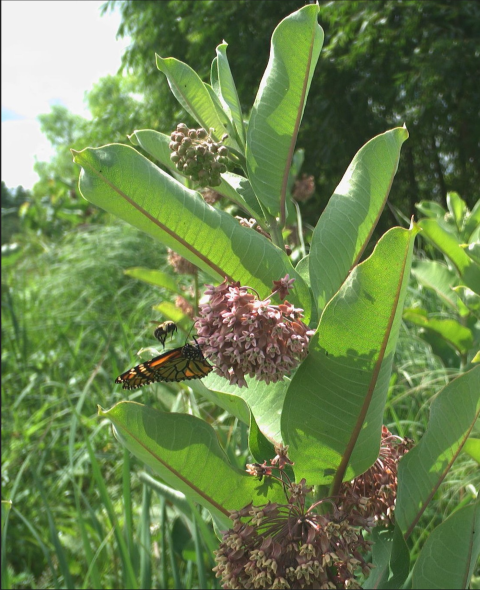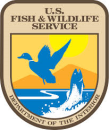Location
States
MissouriEcosystem
PrairieIntroduction
The U.S. Fish and Wildlife Service’s Partners for Fish and Wildlife (PFW) Program provides financial and technical assistance to private landowners in an effort to restore habitat for wildlife. PFW helps design projects to benefit species of concern including those listed as threatened or endangered. Project monitoring within the PFW Program consists of before and after photos of restored habitats as a measure of restoration success. Without time or funding for wildlife monitoring, there is often the assumption that species, including pollinators such as the monarch butterfly (Danaus plexippus), use these habitats once restored.
Since 2015, the PFW Missouri Private Lands Office (MOPLO) has made a focused effort to restore habitats that benefit monarch butterflies as they migrate through Missouri during spring and fall. Monarch butterflies are a species of concern for the U.S. Fish and Wildlife Service, and loss of habitat is the primary driver of population decline. Because PFW works to improve habitat for species of concern, the MOPLO sought to provide evidence that their restoration efforts are providing needed habitat for monarch butterflies.
Although not specializing in research, the MOPLO explored camera traps as a remote monitoring tool for presence/absence of monarch butterflies. Camera traps are motion-activated cameras that use passive infrared sensors to detect movement. Some camera traps can be customized to take continuous photos, record video, or capture photos at regular intervals.
Key Issues Addressed
Monarch butterflies east of the Rocky Mountains in the United States and Mexico (the “eastern population”) have unique phenotypic and genetic variation. This monarch population is thought to be the ancestral origin of all monarchs worldwide, and as such, is important to maintain biodiversity. Furthermore, monarch butterflies are important pollinators in Missouri when they visit during their spring and fall migration. However, monarch numbers have decreased largely due to habitat loss and fragmentation along migration routes as well as overwintering areas in Mexico (eastern population) and California (western population). Additionally, abundance of milkweed (Asclepias spp.), essential for monarch caterpillars, has decreased due to agricultural expansion.
While the PFW Program specializes in habitat restoration, the MOPLO had little documentation of monarch butterflies using their native grassland restoration sites in Missouri. With limited time and funding for monitoring, the MOPLO tested whether camera traps could be used as a time- and cost-efficient option for monitoring use of restored sites by monarch butterflies.
Project Goals
- Explore improved, more efficient, methods for assessing monarch butterfly use of restored native grasslands on private lands
- Test two trail cameras for effectiveness in monitoring of invertebrates
Project Highlights
Improved Detection: MOPLO's success using camera traps to monitor pollinators is supported by Collet & Fisher (2017), who found that camera traps using time-lapse captured 37% more taxa than traditional methods.
- Monitoring Innovations: The MOPLO is a habitat restoration office with no formal research or monitoring focus. However, in order to provide evidence of monarch usage of restored habitats, the MOPLO deployed two commercially available trail cameras on privately owned, restored native grasslands. Both cameras were focused on milkweed flower clusters. Deployment of the cameras ranged from four consecutive days to three weeks. Motion sensors were disabled and time-lapse features were set to take three photos, spaced three seconds apart, every five minutes from 6:00 am to 8:00 pm. This project expanded the office’s scope of work to include research on monitoring methods, yielding a more precise and cost-efficient method for monitoring habitat usage.
- From Ants to Butterflies: Both cameras captured identifiable invertebrate photos. Close focus and time-lapse features allowed for recordings of monarch butterflies, other butterfly species (Lepidoptera), and several species of ants, bees, and wasps (Hymenoptera).
Lessons Learned
Deploying camera traps is an easy and inexpensive process, but processing photos is time-intensive. Using time-lapse features resulted in the collection of a significant number of photos that can be difficult to sort through given time and staffing constraints. Collaborating with other organizations and using volunteers can help with reviewing and sorting through photos.
Camera traps placed in smaller patches of restored habitat captured more photos of monarchs than those placed in larger patches, likely because monarchs in these patches were concentrated on a limited number of milkweed plants near cameras. This contradicts MOPLO’s observational data in the field; MOPLO staff find more monarchs in large patches.
The timing of camera deployment is critical. Monarch butterflies migrate through Missouri in the fall and spring. In 2020, the MOPLO deployed camera traps too early before the migration, resulting in camera batteries dying before monarchs appeared, so they went undetected. Deploying late in the migration season may also result in missed data.
The Passive Infrared (PIR) motion sensors on trail cameras are not capable of detecting movements of invertebrates, therefore time-lapse programming features are required for photo capture. To prevent unscheduled photo captures, inadvertently increasing the number of images to review, motion detection features should be disabled. One camera did not have a function to disable the PIV motion sensor. This was corrected by simply covering the PIR motion sensor on the camera with electrical tape to prevent undesired photo capture.
The MOPLO initially set cameras 24 inches away from milkweed plants, but this length did not produce the best quality photos. Focal lengths of 26 to 27 inches provided the clearest photos. This may vary from camera to camera. Furthermore, pointing cameras to the middle of multiple flower clusters also helped capture better quality photos.
Following the recommended battery types for both cameras (one required lithium batteries and the other required alkaline) yielded long-lived cameras. Neither camera needed battery changes over the longest period of continual image capture (three weeks). Additionally, 32 GB memory cards were large enough to store images during that same three-week period.
Next Steps
- Use camera trap images as outreach materials to landowners and other conservation community partners
- Continue documenting usage of monarch butterflies on restoration sites
- Expand camera trap monitoring to restored woodland, glade, and wetland habitats
- Concurrently place landscape time-lapse cameras to document plant recovery post management actions such as prescribed fire
Resources
- Monarch (Danaus plexippus) Species Status Assessment Report (2020)
- Collett, R. A. and Fisher, D.O. (2017). Time-lapse camera trapping as an alternative to pitfall trapping for estimating activity of leaf litter arthropods.Ecology and Evolution 7(18).
- U.S. Fish and Wildlife Service Partners for Fish and Wildlife Program:
- Illinois Private Lands Office
- Missouri Private Lands Office
Contacts
Chris Woodson, Private Lands Biologist, Partners for Fish and Wildlife Program, U.S. Fish and Wildlife Service: chris_woodson@fws.gov
Case Study Lead Authors
- Madison Bigham, CART Student Intern, University of Arizona
- Chris Woodson, Private Lands Biologist, Partners for Fish and Wildlife Program, U.S. Fish and Wildlife Service: chris_woodson@fws.gov
Suggested Citation
Bigham, M. and Woodson, C. (2021). “Camera Trap Monitoring to Document Pollinator Use of Restored Private Lands in Missouri.” CART. Retrieved from https://www.fws.gov/project/camera-trap-monitoring-document-pollinator-use-restored-private-lands.





